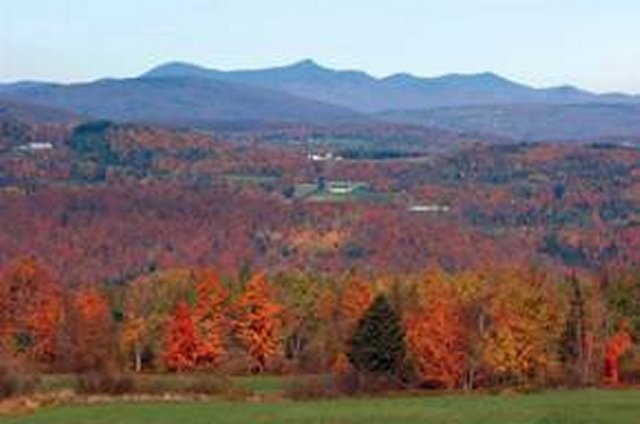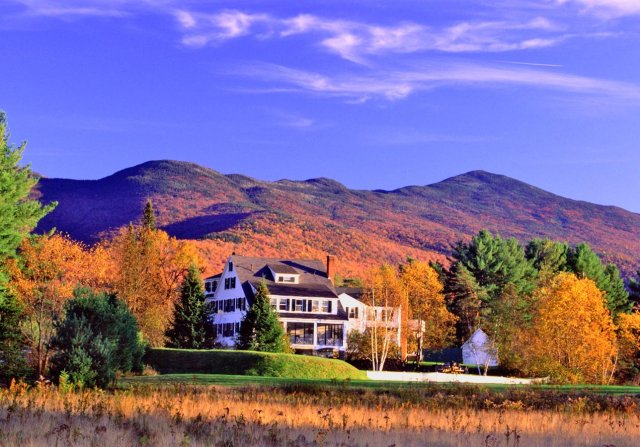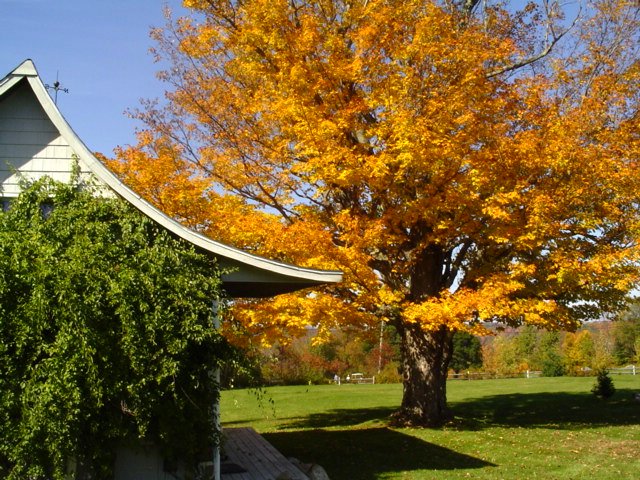When the temperatures are comfortably cool, the air is crisp, and a color blanket is spreading among our glorious foliage
For me the season is a lot of work, but I love the work this time of year even though it is in many ways a season of death

Set 5 (2013) of My
Favorite Foliage Photographs
Bob Jensen at
Trinity University
Before & After
photos of nature's Autumn beauty ---
Click Here
https://www.google.com/search?q=Before+%26+After+photos+of+nature%27s+Autumn+beauty&client=firefox-a&hs=yOK&rls=org.mozilla:en-US:official&channel=fflb&tbm=isch&tbo=u&source=univ&sa=X&ei=XYhoVLPsFdH4yQTmooKwAw&ved=0CB8QsAQ&biw=1024&bih=506&dpr=1.25
Mother Nature is once again painting the mountain slopes in front of my desk.
The full foliage season will once again be late due to not having a hard freeze
in September.
But our mountain inns, hotels, and resorts are filled to the brim with tourists
longing to new colors emerge with each sunrise
The pictures below contain some new and some old shots of our most popular
season of the year
When the temperatures are comfortably cool, the air is crisp, and a color
blanket is spreading among our glorious foliage
For me the season is a lot of work, but I love the work this time of year
even though it is in many ways a season of death

Every year this tree is usually the first color of autumn that we can see from
our lawn
This is Ore Hill as seen from our mail box
Iron ore used to be hauled down on the backs of mules to a smelter for fine
Franconia Iron Stoves
North Kinsman Mountain is in the background

All our wonderful blooming annuals will soon die. I will have to dig them out of
the ground and haul them off.
Soon these New Guinea Impatiens (my favorites that bloom magnificently all
summer) will all look like this
These wonderful plants die when the night temperatures plunge below freezing
Our thousands of wild rose blooms have long since turned into red seed pods that
look like cherry tomatoes
The last blooms to wither in autumn are the alyssum and the domestic roses
that can tolerate cold nights but eventually succumb to deeper cold nights
This is one of my favorite shots of Erika's roses
You can't imagine the work it takes by hand to keep Japanese beetles from eating
the petals
Fortunately, our many wild rose bushes can remain naked all winter, but
the domestic roses have to be covered with mulch and burlap under the added
cover of snow

Autumn is the rutting season when we must be especially careful driving
We once had a moose up here show up for our yard sale
The photograph below was taken by my friend Wes Lavin
Deer and bears scare off rather easily --- not so with a moose in the road

The Mountain View Grand Hotel and Golf Course in early autumn


Franconia Inn where we stayed when we stumbled on the retirement cottage we
eventually bought about three miles away

This is our cottage at 190 Sunset Hill Road
This is an autumn view from inside the living room
The peaked mountain on the left is Mt. Garfield and the highest mountain visible
in the picture is Lafayette



Soon Lafayette and Cannon will be blanketed in snow

We look out at Cannon Mountain about 10 miles to the east
This is a MSNBC photograph of snow and color on Cannon looking down toward our
cottage

Sunrise on the birch grove behind my studio



These are two of my most favorite pictures that I took looking to the north from
my desk
These rainbow pictures taken in autumn were not retouched



You can't believe how much work it is continually sweeping up leaves underneath
this Maple tree

On the other side of this grove our wild flower field is now mowed and awaiting
winter and then spring
Foliage --- http://en.wikipedia.org/wiki/Foliage
A leaf is an organ of a vascular plant, as defined in botanical terms, and in particular in plant morphology. Foliage is a mass noun that refers to leaves as a feature of plants. Typically a leaf is a thin, flattened organ borne above ground and specialized for photosynthesis, but many types of leaves are adapted in ways almost unrecognisable in those terms: some are not flat (for example many succulent leaves and conifers), some are not above ground (such as bulb scales), and some are without major photosynthetic function (consider for example cataphylls, spines, and cotyledons). Conversely, many structures of non-vascular plants, or even of some lichens, which are not plants at all (in the sense of being members of the kingdom Plantae), do look and function much like leaves. Furthermore, several structures found in vascular plants look like leaves but are not actually leaves; they differ from leaves in their structures and origins. Examples include phyllodes, cladodes, and phylloclades
. . .
Leaves in temperate, boreal, and seasonally dry zones may be seasonally deciduous (falling off or dying for the inclement season). This mechanism to shed leaves is called abscission. After the leaf is shed, a leaf scar develops on the twig. In cold autumns, they sometimes change color, and turn yellow, bright-orange, or red, as various accessory pigments (carotenoids and xanthophylls) are revealed when the tree responds to cold and reduced sunlight by curtailing chlorophyll production. Red anthocyanin pigments are now thought to be produced in the leaf as it dies, possibly to mask the yellow hue left when the chlorophyll is lost—yellow leaves appear to attract herbivores such as aphids.
Continued in article
Foliage
Set 4 of My Favorite Foliage Photographs (2012) --- http://www.trinity.edu/rjensen/Tidbits/Foliage/Set14/FoliageSet03.htm
Set 3 --- www.trinity.edu/rjensen/Tidbits/Foliage/Set03/FoliageSet03.htm
Set 2 --- http://www.trinity.edu/rjensen/Tidbits/Foliage/Set02/FoliageSet02.htm
Set 1 --- http://www.trinity.edu/rjensen/tidbits/Foliage/FoliageFavorites.htm
Autumn --- http://www.trinity.edu/rjensen/tidbits/2008/tidbits080925.htm
Also see http://www.trinity.edu/rjensen/tidbits/2009/tidbits090924.htm
Also see http://www.trinity.edu/rjensen/tidbits/2009/tidbits091005.htm
Foliage Network ---
http://www.foliagenetwork.com/default.php (dead link)
Foliage in New Hampshire's White Mountains ---
http://www.nhliving.com/foliage/index.shtml
Fall Foliage ---
http://gonewengland.about.com/cs/fallfoliage/l/blfoliagecentrl.htm
Foliage Pictures ---
http://photo.net/travel/us/ne/foliage
More of Bob Jensen's Pictures and
Stories
http://www.trinity.edu/rjensen/Pictures.htm
Blogs of White
Mountain Hikers (many great photographs) ---
http://www.blogger.com/profile/02242409292439585691
.
White Mountain News --- http://www.whitemtnews.com/
On May 14,
2006 I retired from
Trinity University after a long and
wonderful career as an accounting professor in four universities. I was
generously granted "Emeritus" status by the Trustees of Trinity University. My
wife and I now live in a cottage in the White Mountains of New Hampshire ---
http://www.trinity.edu/rjensen/NHcottage/NHcottage.htm
Bob
Jensen's Blogs ---
http://www.trinity.edu/rjensen/JensenBlogs.htm
Current and past editions of my newsletter called New
Bookmarks ---
http://www.trinity.edu/rjensen/bookurl.htm
Current and past editions of my newsletter called
Tidbits ---
http://www.trinity.edu/rjensen/TidbitsDirectory.htm
Current and past editions of my newsletter called
Fraud Updates ---
http://www.trinity.edu/rjensen/FraudUpdates.htm
Bob Jensen's past presentations and lectures
---
http://www.trinity.edu/rjensen/resume.htm#Presentations
Our
address is 190 Sunset Hill Road, Sugar Hill, New Hampshire
Our cottage was known as the Brayton Cottage in the early 1900s
Sunset Hill is a ridge overlooking with
New Hampshire's White Mountains to the East
and Vermont's
Green Mountains to the West
Bob Jensen's Threads --- http://www.trinity.edu/rjensen/threads.htm
Bob Jensen's Home Page --- http://www.trinity.edu/rjensen/